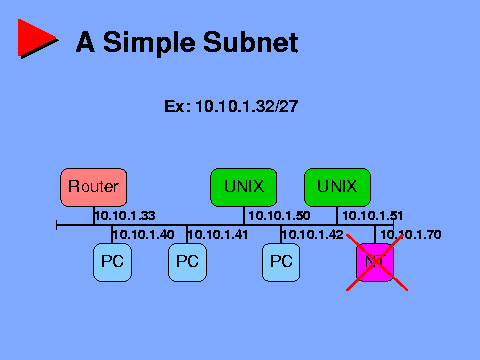Connected: An Internet Encyclopedia
A Simple Subnet
Up:
Connected: An Internet Encyclopedia
Up:
Programmed Instruction Course
Up:
Subnetting and CIDR
Prev: Fundamental Principle of Routing
Next: Reserved Subnet Numbers

A Simple Subnet
Consider a group of hosts attached to an Ethernet
segment. A single IP address prefix would be assigned to the
entire Ethernet, in this example 10.10.1.32/27.
Each device attached to the Ethernet would have a unique
IP address matching the prefix.
The Ethernet, its address prefix,
and its hosts would be collectively refered to as a subnet.
An address such as 10.10.1.70, which doesn't
match the Ethernet's prefix, would not be a valid IP address
on this subnet.
The router on the left would maintain a table listing the Ethernet
addresses for every device on this subnet, and therefore be
capable of delivering packets directly to these hosts.
Routers elsewhere in the network would only maintain a single
entry for the entire subnet, indicating that traffic for
10.10.1.32/27 should be delivered to this router.
An Ethernet with a larger
number of hosts would require a shorter prefix (matching more
addresses), while an Ethernet with only a few hosts could
be assigned a longer prefix.
As a more complex example, consider a group of closely interconnected
Ethernets, each one a subnet. Then there might be a single address prefix
for the entire group. The group's prefix would contain all the
address prefixes for the individual subnets.
Next: Reserved Subnet Numbers
Connected: An Internet Encyclopedia
A Simple Subnet

